A Review on the Policy, Technology and Evaluation Method of Low-Carbon Buildings and Communities
Abstract
:1. Introduction
2. Materials and Methods
- ((ALL = (building material OR building envelope)) AND ALL = (low-carbon OR zero carbon OR zero energy))
- ((((ALL = (community OR building)) AND ALL = (energy system)) AND ALL = (low-carbon OR zero carbon OR zero energy)) AND ALL = (design OR operation))
- (((ALL = (community OR building)) AND ALL = (assessment OR evaluation OR analysis)) AND ALL = (low-carbon OR zero carbon OR zero energy))
3. Low-Carbon Building and Community Policies
3.1. Definition and Projects
3.1.1. Low-Carbon Building
3.1.2. Low-Carbon Community
3.2. Policies for Low-Carbon Buildings and Communities
| Refs. | Country/Union | Policy (Year) | Core Objectives |
|---|---|---|---|
| [27] | United States of America | Net-Zero Energy Commercial Building Initiative (2021) | Net zero energy for all public buildings by 2050. |
| [28] | United Kingdom | Heat and Buildings Strategy (2021) | Reduce greenhouse gas emissions from public places by 75% from 2017 levels by 2037. |
| [29] | European Union | Energy Performance of Buildings Directive (2021) | Zero emissions for all buildings by 2050. |
| [30] | Germany | The German Buildings Energy Act (2020) | All existing buildings will be carbon neutral by 2045. |
| [31] | Estonia | EPBD Implementation in Estonia | Low-rise residential building: 50 kWh/(m2·a) High-rise residential buildings and public buildings: 100 kWh/(m2·a) |
| [33] | Denmark | EPBD Implementation in Denmark | Residential building: 20 kWh/(m2·a) Public building: 25 kWh/(m2·a) |
| [34] | Japan | Plan for Global Warming Countermeasures (2021) | All new buildings will consume zero energy on average by 2030. |
| [36] | China | General code for energy efficiency and renewable energy application in buildings (2021) | The carbon emissions intensity of new buildings should be reduced by more than 7 kg/(m2·a) on average. |
3.3. Incentive Policies
4. Technology Analysis of Buildings and Communities
4.1. Low-Carbon Building Materials and Design
4.1.1. Low-Carbon Building Materials
Alternative Materials and Processes
Natural Materials
4.1.2. Envelope Design
Variety of Low-Carbon Envelope Designs
Efficiency of Various Low-Carbon Envelope Designs
4.2. LCES
4.2.1. Energy System Composition
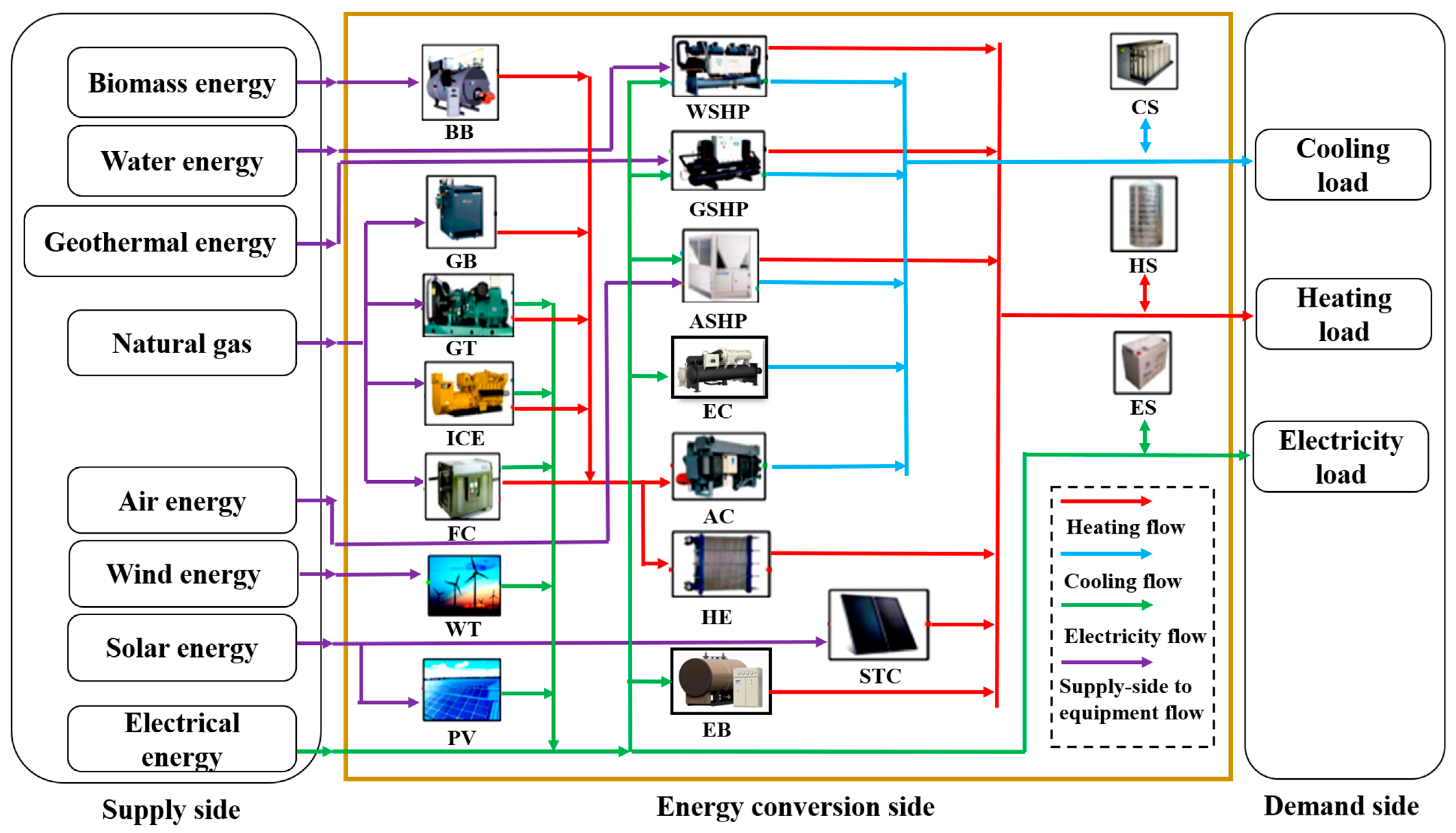
4.2.2. Renewable Energy Technology
4.2.3. Energy Storage Technology
4.2.4. System Optimization Technology
Design Optimization
Operation Optimization
Co-Optimization of Design and Operation
5. Evaluation of Low-Carbon Buildings and Communities
5.1. Low-Carbon Building Evaluation System
5.2. Low-Carbon Community Evaluation System
5.3. LCES Evaluation
5.3.1. Economic Evaluation
5.3.2. Environmental Evaluation
| Refs. | Method | Input Parameters | Application Scope | Characteristics | |
|---|---|---|---|---|---|
| [91,152] | Influence factor decomposition method | IPAT model | Population size, per capita GDP, CO2 intensity | Fossil fuel combustion | Linear analysis |
| STIRPAT model | Population size, per capita GDP, CO2 intensity | Fossil fuel combustion | Nonlinear analysis | ||
| LMDI model | Emissions intensity, energy structure, energy intensity and economic development | Fossil fuel combustion | Dynamic variation analysis | ||
| Kara model | Emissions intensity, energy intensity, per capita income, population size | Fossil fuel combustion | Dynamic variation analysis | ||
| Lespeyres decomposition method | Changes in total output, industrial structure and carbon emissionsintensity in various industrial sectors | Fossil fuel combustion | Dynamic variation analysis | ||
| [91,153] | Measurement method | - | Air flow, CO2 concentration, conversion factor | Land use change and forests | Precision, high measurement requirements |
| [91,154] | Material balance method | - | Total input materials | Industrial production | Complete basic data records are required with reliable results |
| [91,154] | IPCC list method | - | Fuel consumption, emissions factors | Fossil fuel combustion | Simple and practical calculation |
5.3.3. Technology Evaluation
5.3.4. Comprehensive Evaluation
6. Enablers and Barriers
6.1. Government Policies and Public Attitude
6.2. Technology
6.3. Evaluation
7. Conclusions
- This paper introduced some mature examples of low-carbon buildings and communities that effectively utilize new energy and storage technologies to optimize energy systems, save resources, and reduce carbon emissions. The review also summarized building energy efficiency and incentive policies in most countries. Developed countries such as the United States and the European Union promulgated and implemented low-carbon buildings and communities policies earlier, and their policies were more systematic and comprehensive. At present, the policy focus is on the application of electrification and intelligentization in buildings, which enables buildings to better reduce carbon emissions and facilitates the monitoring of building energy consumption by the government and individuals. The incentive policies for low-carbon buildings and communities in developed countries focus on giving incentives and subsidies according to the grading system of their own low-carbon buildings and communities evaluation systems, while the relevant incentive policies in China and other developing countries pay more attention to the energy-saving transformation of existing buildings. At the same time, due to the different levels of economic and technological development of provinces in China, there are differences in financial subsidies among different regions. This paper also reveals that in developing countries, the economic concept of low-carbon buildings and communities lacks strong support from the government in the financial market, resulting in a small proportion of individual capital investment, which has resulted in the vitality of low-carbon buildings and community markets not being stimulated to the maximum extent. This has implications for other countries in the development of low-carbon buildings and communities in the future;
- In terms of technology, CO2 emissions are reduced mainly from the construction and operation of buildings and communities. For construction, most research currently uses wood instead of traditional reinforced concrete, prefabricated instead of traditional construction methods, and reasonable envelope structures to reduce building loads. For operation, renewable energy technologies and energy storage technologies are needed to establish a low-carbon energy system. The economic, environmental and energy efficiency of energy systems can be improved through optimization techniques;
- The rating system of low-carbon buildings and communities is relatively mature at present, but the development level of low-carbon economy varies from country, and the application of evaluation system has its own emphasis. The existing low-carbon buildings and communities evaluation systems generally assess and assign points to different aspects, such as factors affecting building or community living and energy consumption, and then evaluate the grade through the score. Among these, the evaluation of LCESs has focused on economic, environmental, and technological aspects, and many evaluation indicators and methods have been applied;
- The development of low-carbon buildings and communities depends on the mandatory norms and incentive policies of the government. Meanwhile, the cultivation of low-carbon building talents, the improvement of financial markets and the public’s attitude towards environmental protection also have a profound impact on the development of low-carbon buildings and communities. In terms of technology, the development of low-carbon building materials and designs is limited due to high cost, the lack of knowledge, and standards. For LCESs, natural gas and the power grid are often used as auxiliary energy, which still has large CO2 emissions. Hydrogen production to store renewable energy for power generation is promising for zero-carbon energy systems in low-carbon buildings and communities. In addition, it is necessary to establish a comprehensive and universal optimization system, including optimization methods, algorithms, and platforms. In terms of evaluation, some countries have serious limitations and one-sidedness in specific evaluation systems, and lack comprehensive evaluation systems for different types of low-carbon buildings and communities.
Author Contributions
Funding
Data Availability Statement
Conflicts of Interest
Abbreviations
| AA-CAES | advanced adiabatic compressed air energy storage |
| ABC | artificial bee colony |
| ABSO | artificial bee swarm optimization |
| AC | absorption chillers |
| AHP | Analytic Hierarchy Process |
| ALO | ant lion optimization |
| ASHP | air source heat pumps |
| BB | Biomass boiler |
| Bed ZED | Beddington Zero Energy Development |
| BEE | building environmental efficiency |
| BIGP | building envelope integrated green plants |
| BIPV | building-integrated photovoltaics |
| BREEAM | Building Research Establishment Environmental Assessment Method |
| CAES | compressed air energy storage |
| CASBEE | Comprehensive Assessment System for Building Environmental Efficiency |
| CASBEE-UD | CASBEE for Urban development |
| CASGB | Chinese Assessment Standard for Green Building |
| CERR | CO2 emissionsreduction ratio |
| CHP | combined heat and power generation |
| CCHP | combined cooling, heating and power generation |
| CS | cold storage |
| CWT | cold water tank |
| DG | diesel generator |
| DGNB | Deutsche Gütesiegel für Nachhaltiges Bauen/German Sustainable Building Certification Standards |
| DES | distributed energy system |
| DR | demand response |
| EB | electric boiler |
| EC | electric chillers |
| ELECTRE | Elimination et choice translating reality |
| EPBD | Energy Performance of Buildings Directive |
| ES | electricity storage |
| EV | Electric Vehicle |
| FC | Fuel cell |
| GA | genetic algorithm |
| GB | gas boiler |
| GEG | the German Building Energy Act (Gebäudeenergiegesetz) |
| GLIDES | ground-level integrated diverse energy storage |
| GPC | geopolymer concrete |
| GRA | gray relational analysis |
| GSHP | ground source heat pump |
| GT | gas turbines |
| GWO | grey wolf optimization |
| HDE | hydroelectricity |
| HDS | hydrogen storage |
| HE | heating exchanger |
| HES | hybrid energy system |
| HQE | High Environmental Quality |
| HOMER | Hybrid Optimization of Multiple Energy Resources |
| HP | heat pump |
| HS | heat storage |
| HSA | harmony search algorithm |
| HWT | hot water tank |
| IALA | improved ant lion algorithm |
| ICA | imperialist competitive algorithm |
| ICE | internal combustion engine |
| IEA | International Energy Agency |
| IES | integrated energy system |
| IPCC | Intergovernmental Panel on Climate Change |
| LB | lithium battery |
| LCE | levelized cost of energy |
| LCES | low-carbon energy systems |
| LEEDTM | Leadership in Energy and Environmental Design |
| LEED-ND | LEED for Neighborhood Development |
| LINMAP | Linear Programming Techniques for Multi-dimensional Analysis of Preference |
| LP | linear programming |
| MES | multi-energy system |
| MILP | mixed integer linear programming |
| MIP | mixed integer programming |
| MOBO | Multi-Objective Building Optimizer |
| NLP | nonlinear programming |
| NSGA-II | non-dominated ranking genetic algorithm |
| OPC | ordinary Portland cement |
| PCM | phase change material |
| PER | primary energy ratio |
| PESR | primary energy savings rate |
| PHS | pumped hydro energy storage |
| PROMETHEE | preference ranking organization method for enrichment evaluation |
| PSO | particle swarm optimization |
| PSA | particle search algorithm |
| PV | photovoltaic |
| PVT-ST | series connection between photovoltaic thermal module and solar thermal collector |
| RES | renewable energy system |
| ROSO | robust-stochastic optimization |
| SA | simulated annealing |
| SCE | shuffled complex evolution |
| SDP | stochastic dynamic programming |
| SMART | Simple multi-attribute rating technique |
| SPS | separated production system |
| SQP | sequential quadratic programming |
| STC | solar thermal collectors |
| TOPSIS | Technique for Order of Preference by Similarity to Ideal Solution |
| TLBO | teaching learning-based optimization |
| WDO | wind-driven optimization |
| WHB | waste heat boiler |
| WHRU | waste heat recovery units |
| World GBC | World Green Building Council |
| WOA | whale optimization algorithm |
| WSHP | water source heat pumps |
| WT | wind turbine |
| WWF | World Wide Fund for Nature |
| ZEB | Zero Energy Building |
References
- Global Warming of 1.5 °C. Available online: https://www.ipcc.ch/sr15/ (accessed on 20 September 2022).
- Net Zero Tracker. Available online: https://zerotracker.net/ (accessed on 20 September 2022).
- Net Zero Emissions Race-2022 Scorecard, Energy & Climate Intelligence Unit. Available online: https://eciu.net/netzerotracker (accessed on 20 October 2022).
- A European Green Deal, European Commission. Available online: https://ec.europa.eu/info/strategy/priorities-2019-2024/european-green-deal_en (accessed on 20 September 2022).
- European Climate Law, European Commission. Available online: https://climate.ec.europa.eu/eu-action/european-green-deal/european-climate-law_en (accessed on 20 September 2022).
- Climate Change Act, United Kingdom Government. Available online: https://www.legislation.gov.uk/primary+secondary?title=Climate%20Change%20Act (accessed on 20 September 2022).
- Federal Climate Change Act, Federal Republic of Germany. Available online: https://www.gesetze-im-internet.de/englisch_ksg/englisch_ksg.html (accessed on 20 September 2022).
- Climate Action Programme 2030, Federal Republic of Germany. Available online: https://www.bundesfinanzministerium.de/Content/EN/FAQ/climate-protection-faq.html (accessed on 20 September 2022).
- National Low-Carbon Strategy (SNBC), the French Republic. Available online: https://climate-laws.org/geographies/france/policies/national-low-carbon-strategy-snbc (accessed on 20 September 2022).
- Sweden’s Climate Policy Framework, Climate Act. Available online: https://www.government.se/articles/2021/03/swedens-climate-policy-framework/ (accessed on 20 September 2022).
- Climate Change Response (Zero Carbon) Amendment Bill, New Zealand. Available online: https://www.parliament.nz/en/pb/sc/reports/document/SCR_92789/climate-change-response-zero-carbon-amendment-bill (accessed on 20 September 2022).
- Leaders’ Climate Summit. Available online: http://www.gov.cn/xinwen/2021-04/22/content_5601515.htm (accessed on 20 September 2022).
- Yang, J.; Hao, Y.; Feng, C. A race between economic growth and carbon emissions: What play important roles towards global low-carbon development? Energy Econ 2021, 100, 105327. [Google Scholar] [CrossRef]
- World Green Building Trends 2018, World Green Building Council. Available online: https://www.worldgbc.org/news-media/world-green-building-trends-2018-smartmarket-report-publication (accessed on 20 September 2022).
- Wilkinson Eyre Architects, The Crystal, London, UK. Available online: https://www.wilkinsoneyre.com/projects/the-crystal (accessed on 20 September 2022).
- Pixel Building, Integral Group. Available online: https://www.integralgroup.com/projects/pixel-building/ (accessed on 20 September 2022).
- Bullitt Foundation, Bullitt Center, Building Features. Available online: https://bullittcenter.org/building/building-features/ (accessed on 20 September 2022).
- Gao, W.; Novianto, D. Eco-House in Kitakyushu, Japan. In Sustainable Houses and Living in the Hot-Humid Climates of Asia; Kubota, T., Rijal, H.B., Takaguchi, H., Eds.; Springer Singapore: Singapore, 2018; pp. 483–490. [Google Scholar]
- Bahrain World Trade Center, Manama, Bahrain. Available online: https://www.otis.com/en/us/our-company/global-projects/project-showcase/bahrain-world-trade-center (accessed on 20 September 2022).
- Dong, F.; Wang, Y.; Su, B.; Hua, Y.F.; Zhang, Y.Q. The process of peak CO2 emissions in developed economies: A perspective of industrialization and urbanization. Resour. Conserv. Recycl. 2019, 141, 61–75. [Google Scholar] [CrossRef]
- Tan, X.C.; Lai, H.P.; Gu, B.H.; Zeng, Y.; Li, H. Carbon emission and abatement potential outlook in China’s building sector through 2050. Energy Policy 2018, 118, 429–439. [Google Scholar] [CrossRef]
- Shi, L.; Xu, T.; Gao, L.; Han, L.; Li, Q. Low carbon community research under sustainability context. Sheng Tai Xue Bao 2018, 38, 5170–5177. [Google Scholar]
- Beddington Zero Energy Development, United Kingdom. Available online: https://www.greenroofs.com/projects/bedzed-beddington-zero-energy-development/ (accessed on 20 September 2022).
- Vauban in Freiburg, Germany. Available online: https://www.greencitytimes.com/europes-greenest-city-district/ (accessed on 20 September 2022).
- 2021 Global Status Report for Buildings and Construction. Available online: https://www.unep.org/resources/report/2021-global-status-report-buildings-and-construction (accessed on 20 September 2022).
- Planning for Federal Sustainability in the Next Decade, United States of America. Available online: https://www.govinfo.gov/content/pkg/FR-2015-03-25/pdf/2015-07016.pdf (accessed on 20 September 2022).
- Net-Zero Energy Commercial Building Initiative, U.S. Department of Energy • Office of Energy Efficiency and Renewable Energy. Available online: https://www.govinfo.gov/content/pkg/USCODE-2020-title42/pdf/USCODE-2020-title42-chap152-subchapIII-partB-sec17082.pdf (accessed on 20 September 2022).
- Heat and Buildings Strategy, United Kingdom. Available online: https://assets.publishing.service.gov.uk/government/uploads/system/uploads/attachment_data/file/1044598/6.7408_BEIS_Clean_Heat_Heat___Buildings_Strategy_Stage_2_v5_WEB.pdf (accessed on 20 September 2022).
- Energy Performance of Buildings Directive, European Commission. Available online: https://energy.ec.europa.eu/topics/energy-efficiency/energy-efficient-buildings/energy-performance-buildings-directive_en (accessed on 20 September 2022).
- The German Buildings Energy Act (Gebäudeenergiegesetz, GEG), German Federal Republic. Available online: https://www.energie-experten.org/energie-sparen/energieberatung/gebaeudeenergiegesetz (accessed on 20 September 2022).
- EPBD Implementation in Estonia Status in December 2016. Available online: https://www.epbd-ca.eu/wp-content/uploads/2018/08/CA-EPBD-IV-Estonia-2018.pdf (accessed on 20 September 2022).
- Implementation of the EPBD Estonia Status in 2020. Available online: https://epbd-ca.eu/wp-content/uploads/2022/10/Implementation-of-the-EPBD-in-Estonia.pdf (accessed on 20 September 2022).
- EPBD Implementation in Denmark Status in December 2016. Available online: http://epbd-ca.eu/wp-content/uploads/2018/08/CA-EPBD-IV-Denmark-2018.pdf (accessed on 20 September 2022).
- Plan for Global Warming Countermeasures, Ministry of the Environment, Japan. Available online: https://www.env.go.jp/press/110060.html (accessed on 20 September 2022).
- Li, H.; Zhang, S.; Okumiya, M.; Yoon, G. Japan Zero Energy Building Development Status. Build. Sci. 2017, 33, 142–148. [Google Scholar]
- General Code for Energy Efficiency and Renewable Energy Application in Buildings, the People’s Republic of China. Available online: https://www.mohurd.gov.cn/gongkai/fdzdgknr/zfhcxjsbwj/202110/20211013_762460.html (accessed on 20 September 2022).
- Olubunmi, O.A.; Xia, P.B.; Skitmore, M. Green building incentives: A review. Renew. Sust. Energ. Rev. 2016, 59, 1611–1621. [Google Scholar] [CrossRef]
- Hope, A.J.; Booth, A. Attitudes and behaviours of private sector landlords towards the energy efficiency of tenanted homes. Energy Policy 2014, 75, 369–378. [Google Scholar] [CrossRef]
- Davies, P.; Osmani, M. Low carbon housing refurbishment challenges and incentives: Architects’ perspectives. Build Environ 2011, 46, 1691–1698. [Google Scholar] [CrossRef]
- Marchand, R.D.; Koh, S.C.L.; Morris, J.C. Delivering energy efficiency and carbon reduction schemes in England: Lessons from Green Deal Pioneer Places. Energy Policy 2015, 84, 96–106. [Google Scholar] [CrossRef]
- Cease, B.; Kim, H.; Kim, D.; Ko, Y.; Cappel, C. Barriers and incentives for sustainable urban development: An analysis of the adoption of LEED-ND projects. J. Environ. Manage. 2019, 244, 304–312. [Google Scholar] [CrossRef]
- The Connecticut LEED Requirements (the Proposed Regulations). Available online: https://nerej.com/connecticut-takes-the-leed-in-sustainable-development-part-ii (accessed on 20 September 2022).
- LEED Requirement in Connecticut. Available online: https://leeduser.buildinggreen.com/forum/leed-requirement-connecticut (accessed on 20 September 2022).
- Shazmin, S.A.A.; Sipan, I.; Sapri, M. Property tax assessment incentives for green building: A review. Renew. Sust. Energ. Rev. 2016, 60, 536–548. [Google Scholar] [CrossRef]
- Li, Y.; Liang, M. The economic development incentive mechanism for the existing energy-saving building structure in the perspective of game analysis. Int. J. Low-Carbon Tec. 2018, 13, 250–254. [Google Scholar] [CrossRef]
- Zou, Y.H. Certifying green buildings in China: LEED vs. 3-star. J. Clean. Prod. 2019, 208, 880–888. [Google Scholar] [CrossRef]
- Zou, Y.H.; Zhao, W.X.; Zhong, R.J. The spatial distribution of green buildings in China: Regional imbalance, economic fundamentals, and policy incentives. Appl. Geogr. 2017, 88, 38–47. [Google Scholar] [CrossRef]
- Interim Measures of Beijing Municipal Incentive Fund Administration for Prefabricated Buildings, Green Buildings and Green Ecological Demonstration Area Projects, the People’s Government of Beijing, China. Available online: http://zjw.beijing.gov.cn/bjjs/xxgk/fgwj3/gfxwj/zfcxjswwj/1791103/index.shtml (accessed on 20 September 2022).
- “14th Five-Year Plan” Building Energy Conservation and Green Building Development Plan, Government of the People’s Republic of China. Available online: http://www.gov.cn/zhengce/zhengceku/2022-03/12/content_5678698.htm (accessed on 20 September 2022).
- Mata, É.; Peñaloza, D.; Sandkvist, F.; Nyberg, T. What is stopping low-carbon buildings? A global review of enablers and barriers. Energy Res. Soc. Sci. 2021, 82, 102261. [Google Scholar] [CrossRef]
- Chan, M.; Masrom, M.A.N.; Yasin, S.S. Selection of Low-Carbon Building Materials in Construction Projects: Construction Professionals’ Perspectives. Buildings 2022, 12, 486. [Google Scholar] [CrossRef]
- Orsini, F.; Marrone, P. Approaches for a low-carbon production of building materials: A review. J. Clean. Prod. 2019, 241, 118380. [Google Scholar] [CrossRef]
- Saranya, P.; Nagarajan, P.; Shashikala, A.P. Eco-Friendly GGBS Concrete: A State-of-The-Art Review. In Proceedings of the International Conference on Recent Advances in Materials, Hyderabad, India, 1–2 June 2017. [Google Scholar]
- Sutton, A.; Black, D.; Walker, P. Unfired clay masonry: An introduction to low-impact building materials. Inf. Pap. BRE Publ. 2011, 15, 1–6. [Google Scholar]
- Lamnatou, C.; Moreno, A.; Chemisana, D.; Reitsma, F.; Claria, F. Ethylene tetrafluoroethylene (ETFE) material: Critical issues and applications with emphasis on buildings. Renew. Sust. Energ. Rev. 2018, 82, 2186–2201. [Google Scholar] [CrossRef]
- Neupane, K. High-Strength Geopolymer Concrete- Properties, Advantages and Challenges. Adv. Mater. 2018, 7, 15–25. [Google Scholar] [CrossRef]
- Venkatarama Reddy, B.V. Sustainable materials for low carbon buildings. Int. J. Low Carbon Technol. 2009, 4, 175–181. [Google Scholar] [CrossRef]
- Davidovits, J. Green Chemistry and Sustainable Development Solutions. In Proceedings of the World Congress Geopolymer 2005; Geopolymer Institute: Saint-Quentin, France, 2005. [Google Scholar]
- Pasupathy, K.; Berndt, M.; Sanjayan, J.; Pathmanathan, R. Durability Performance of Concrete Structures Built with Low Carbon Construction Materials. Energy Procedia 2016, 88, 794–799. [Google Scholar] [CrossRef]
- Mao, C.; Shen, Q.; Shen, L.; Tang, L. Comparative study of greenhouse gas emissions between off-site prefabrication and conventional construction methods: Two case studies of residential projects. Energy Build. 2013, 66, 165–176. [Google Scholar] [CrossRef] [Green Version]
- Cao, X.; Li, X.; Zhu, Y.; Zhang, Z. A comparative study of environmental performance between prefabricated and traditional residential buildings in China. J. Clean. Prod. 2015, 109, 131–143. [Google Scholar] [CrossRef]
- Park, C.-S.; Lee, D.-Y.; Kwon, O.-S.; Wang, X. A framework for proactive construction defect management using BIM, augmented reality and ontology-based data collection template. Autom. Constr. 2013, 33, 61–71. [Google Scholar] [CrossRef]
- Meža, S.; Turk, Ž.; Dolenc, M. Measuring the potential of augmented reality in civil engineering. Adv. Eng. Softw. 2015, 90, 1–10. [Google Scholar] [CrossRef]
- Crishna, N.; Banfill, P.F.G.; Goodsir, S. Embodied energy and CO2 in UK dimension stone. Resour Conserv Recycl 2011, 55, 1265–1273. [Google Scholar] [CrossRef]
- Andrew, H. Buchanana, S.B.L. Wood-Based building materials and atmospheric. Environ. Sci. Policy 1999, 2, 427–437. [Google Scholar]
- Himes, A.; Busby, G. Wood buildings as a climate solution. Dev. Built Environ. 2020, 4, 100030. [Google Scholar] [CrossRef]
- Nurdiah, E.A. The Potential of Bamboo as Building Material in Organic Shaped Buildings. Procedia—Soc. Behav. Sci. 2016, 216, 30–38. [Google Scholar] [CrossRef]
- van der Lugt, P.; van den Dobbelsteen, A.A.J.F.; Janssen, J.J.A. An environmental, economic and practical assessment of bamboo as a building material for supporting structures. Constr. Build Mater. 2006, 20, 648–656. [Google Scholar] [CrossRef]
- Chele, E.-S.; Ricardo, M.-C.; Ana, P.-M.; Teresa, M.-R. Bamboo, from Traditional Crafts to Contemporary Design and Architecture. Procedia—Soc. Behav. Sci. 2012, 51, 777–781. [Google Scholar] [CrossRef]
- Sadineni, S.B.; Madala, S.; Boehm, R.F. Passive building energy savings: A review of building envelope components. Renew. Sust. Energ. Rev. 2011, 15, 3617–3631. [Google Scholar] [CrossRef]
- da Cunha, S.R.L.; de Aguiar, J.L.B. Phase change materials and energy efficiency of buildings: A review of knowledge. J. Energy Storage 2020, 27, 101083. [Google Scholar] [CrossRef]
- Zhang, Y.; Zhang, L.; Meng, Q. Dynamic heat transfer model of vertical green façades and its co-simulation with a building energy modelling program in hot-summer/warm-winter zones. J. Build. Eng. 2022, 58, 105008. [Google Scholar] [CrossRef]
- Tan, H.; Hao, X.; Long, P.; Xing, Q.; Lin, Y.; Hu, J. Building envelope integrated green plants for energy saving. Energy Explor. Exploit. 2019, 38, 222–234. [Google Scholar] [CrossRef]
- Ke, Y.; Chen, J.; Lin, G.; Wang, S.; Zhou, Y.; Yin, J.; Lee, P.S.; Long, Y. Smart Windows: Electro-, Thermo-, Mechano-, Photochromics, and Beyond. Adv. Energy Mater. 2019, 9, 1902066. [Google Scholar] [CrossRef]
- Cai, G.; Wang, J.; Lee, P.S. Next-Generation Multifunctional Electrochromic Devices. Acc. Chem. Res. 2016, 49, 1469–1476. [Google Scholar] [CrossRef]
- Rosseinsky, J.R.; Monk, P.M.; Mortimer, R.J. Electrochromic Materials and Devices; John Wiley & Sons: Weinheim, German, 2015; p. 672. [Google Scholar]
- Zhou, D.; Xie, D.; Xia, X.; Wang, X.; Gu, C.; Tu, J. All-Solid-State electrochromic devices based on WO3||NiO films: Material developments and future applications. Sci. China Chem. 2017, 60, 3–12. [Google Scholar] [CrossRef]
- Yang, P.; Sun, P.; Mai, W. Electrochromic energy storage devices. Mater. Today 2016, 19, 394–402. [Google Scholar] [CrossRef]
- Cui, Y.; Ke, Y.; Liu, C.; Chen, Z.; Wang, N.; Zhang, L.; Zhou, Y.; Wang, S.; Gao, Y.; Long, Y. Thermochromic VO2 for Energy-Efficient Smart Windows. Joule 2018, 2, 1707–1746. [Google Scholar] [CrossRef]
- Ke, Y.; Zhou, C.; Zhou, Y.; Wang, S.; Chan, S.H.; Long, Y. Emerging Thermal-Responsive Materials and Integrated Techniques Targeting the Energy-Efficient Smart Window Application. Adv. Funct. Mater. 2018, 28, 1800113. [Google Scholar] [CrossRef]
- Gao, Y.; Luo, H.; Zhang, Z.; Kang, L.; Chen, Z.; Du, J.; Kanehira, M.; Cao, C. Nanoceramic VO2 thermochromic smart glass: A review on progress in solution processing. Nano Energy 2012, 1, 221–246. [Google Scholar] [CrossRef]
- Long, L.; Ye, H. How to be smart and energy efficient: A general discussion on thermochromic windows. Sci. Rep. 2014, 4, 6427. [Google Scholar] [CrossRef] [PubMed] [Green Version]
- Xia, B.; Li, X. Analysis and comparison on the potential of low-carbon architectural design strategies. Sustain. Comput. -Infor. 2019, 21, 204–211. [Google Scholar] [CrossRef]
- Li, S.; Cui, Y.; Banaitienė, N.; Liu, C.; Luther, M.B. Sensitivity Analysis for Carbon Emissions of Prefabricated Residential Buildings with Window Design Elements. Energies 2021, 14, 6436. [Google Scholar] [CrossRef]
- Arumugam, P.; Ramalingam, V.; Vellaichamy, P. Effective PCM, insulation, natural and/or night ventilation techniques to enhance the thermal performance of buildings located in various climates—A review. Energy Build. 2022, 258, 111840. [Google Scholar] [CrossRef]
- Mokhtara, C.; Negrou, B.; Settou, N.; Settou, B.; Samy, M.M. Design optimization of off-grid Hybrid Renewable Energy Systems considering the effects of building energy performance and climate change: Case study of Algeria. Energy 2021, 219, 119605. [Google Scholar] [CrossRef]
- Sobhani, H.; Shahmoradi, F.; Sajadi, B. Optimization of the renewable energy system for nearly zero energy buildings: A future-oriented approach. Energy Convers. Manag. 2020, 224, 113370. [Google Scholar] [CrossRef]
- Yang, G.; Zhai, X.Q. Optimal design and performance analysis of solar hybrid CCHP system considering influence of building type and climate condition. Energy 2019, 174, 647–663. [Google Scholar] [CrossRef]
- Rikkas, R.; Lahdelma, R. Energy supply and storage optimization for mixed-type buildings. Energy 2021, 231, 120839. [Google Scholar] [CrossRef]
- Zhao, H.; Xu, J.; Xu, K.; Sun, J.; Wang, Y. Optimal Allocation Method of Source and Storage Capacity of PV-Hydrogen Zero Carbon Emission Microgrid Considering the Usage Cost of Energy Storage Equipment. Energies 2022, 15, 4916. [Google Scholar] [CrossRef]
- Liu, C.; Wang, H.; Wang, Z.; Liu, Z.; Tang, Y.; Yang, S. Research on life cycle low carbon optimization method of multi-energy complementary distributed energy system: A review. J. Clean. Prod. 2022, 336, 130380. [Google Scholar] [CrossRef]
- Liu, Z.; Li, Y.; Fan, G.; Wu, D.; Guo, J.; Jin, G.; Zhang, S.; Yang, X. Co-Optimization of a novel distributed energy system integrated with hybrid energy storage in different nearly zero energy community scenarios. Energy 2022, 247, 123553. [Google Scholar] [CrossRef]
- Wang, X.; Chen, X.; Fang, L.; Jia, Q.; Ma, L.; Chen, L.; Mei, S. Optimal Dispatching of Ladder-Type Carbon Trading in Integrated Energy System With Advanced Adiabatic Compressed Air Energy Storage. Front. Energy Res. 2022, 10, 1057. [Google Scholar] [CrossRef]
- Sun, H.; Ren, Q.; Hou, J.; Zhao, Z.; Xie, D.; Zhao, W.; Meng, F. Study on the performance and economy of the building-integrated micro-grid considering photovoltaic and pumped storage: A case study in Foshan. Int. J. Low Carbon Technol. 2022, 17, 630–636. [Google Scholar] [CrossRef]
- Dong, X.; Liu, Y.; Xu, Z.; Wu, J.; Liu, J.; Guan, X. Optimal Scheduling of Distributed Hydrogen-based Multi-Energy Systems for Building Energy Cost and Carbon Emission Reduction. In Proceedings of the 16th IEEE International Conference on Automation Science and Engineering (CASE), Hong Kong, China, 20–21 August 2020; IEEE: Hong Kong, China, 2020. [Google Scholar]
- Wang, Z.; Li, X.; Li, Y.; Zhao, T.; Xia, X.; Zhang, H. An Optimization Framework for Low-Carbon Oriented Integrated Energy System Management in Commercial Building under Electric Vehicle Demand Response. Processes 2021, 9, 1737. [Google Scholar] [CrossRef]
- Wei, L.; Xv, S. Optimal scheduling of building integrated energy systems using an improved ant lion algorithm. Int. J. Low Carbon Technol. 2022, 17, 720–729. [Google Scholar] [CrossRef]
- Tian, X.; Zhou, Y.; Morris, B.; You, F. Sustainable design of Cornell University campus energy systems toward climate neutrality and 100% renewables. Renew. Sust. Energ. Rev. 2022, 161, 112383. [Google Scholar] [CrossRef]
- Fangjie, G.; Jianwei, G.; Yi, Z.; Ningbo, H.; Haoyu, W. Community decision-makers’ choice of multi-objective scheduling strategy for integrated energy considering multiple uncertainties and demand response. Sustain. Cities Soc. 2022, 83, 103945. [Google Scholar] [CrossRef]
- Ma, T.; Li, M.; Kazemian, A. Photovoltaic thermal module and solar thermal collector connected in series to produce electricity and high-grade heat simultaneously. Appl. Energy 2020, 261, 114380. [Google Scholar] [CrossRef]
- Chen, Y.; Abu-Heiba, A.; Kassaee, S.; Liu, C.; Liu, G.; Starke, M.; Smith, B.T.; Momen, A.M. Coupled Heat Power Operation of Smart Buildings via Modular Pumped Hydro Storage. J Energy Resour Technol 2022, 144, 070912. [Google Scholar] [CrossRef]
- Chen, Y.; Dababneh, F.; Zhang, B.; Kassaee, S.; Smith, B.T.; Liu, X.; Momen, A.M. Surrogate Modeling for Capacity Planning of Charging Station Equipped With Photovoltaic Panel and Hydropneumatic Energy Storage. J Energy Resour Technol 2020, 142, 050907. [Google Scholar] [CrossRef]
- Alturki, A.A. Optimal design for a hybrid microgrid-hydrogen storage facility in Saudi Arabia. Energy Sustain. Soc. 2022, 12, 24. [Google Scholar] [CrossRef] [PubMed]
- Alabi, T.M.; Aghimien, E.I.; Agbajor, F.D.; Yang, Z.; Lu, L.; Adeoye, A.R.; Gopaluni, B. A review on the integrated optimization techniques and machine learning approaches for modeling, prediction, and decision making on integrated energy systems. Renew. Energ. 2022, 194, 822–849. [Google Scholar] [CrossRef]
- Feng, G.; Wang, G.; Li, Q.; Zhang, Y.; Li, H. Investigation of a solar heating system assisted by coupling with electromagnetic heating unit and phase change energy storage tank: Towards sustainable rural buildings in northern China. Sustain. Cities Soc. 2022, 80, 103449. [Google Scholar] [CrossRef]
- Koutroulis, E.; Kolokotsa, D.; Potirakis, A.; Kalaitzakis, K. Methodology for optimal sizing of stand-alone photovoltaic/wind-generator systems using genetic algorithms. Sol. Energy 2006, 80, 1072–1088. [Google Scholar] [CrossRef]
- Yuan, X.; Heikari, L.; Hirvonen, J.; Liang, Y.; Virtanen, M.; Kosonen, R.; Pan, Y. System modelling and optimization of a low temperature local hybrid energy system based on solar energy for a residential district. Energy Convers. Manag. 2022, 267, 115918. [Google Scholar] [CrossRef]
- Kümpel, A.; Stoffel, P.; Müller, D. Development of a Long-Term Operational Optimization Model for a Building Energy System Supplied by a Geothermal Field. J. Therm. Sci. 2022, 31, 1293–1301. [Google Scholar] [CrossRef]
- Alabi, T.M.; Lu, L.; Yang, Z. Improved hybrid inexact optimal scheduling of virtual powerplant (VPP) for zero-carbon multi-energy system (ZCMES) incorporating Electric Vehicle (EV) multi-flexible approach. J. Clean. Prod. 2021, 326, 129294. [Google Scholar] [CrossRef]
- Vahid-Pakdel, M.J.; Nojavan, S.; Mohammadi-ivatloo, B.; Zare, K. Stochastic optimization of energy hub operation with consideration of thermal energy market and demand response. Energy Convers. Manag. 2017, 145, 117–128. [Google Scholar] [CrossRef]
- Bagherian, M.A.; Mehranzamir, K.; Pour, A.B.; Rezania, S.; Taghavi, E.; Nabipour-Afrouzi, H.; Dalvi-Esfahani, M.; Alizadeh, S.M. Classification and Analysis of Optimization Techniques for Integrated Energy Systems Utilizing Renewable Energy Sources: A Review for CHP and CCHP Systems. Processes 2021, 9, 339. [Google Scholar] [CrossRef]
- Yang, X.; Liu, K.; Leng, Z.; Liu, T.; Zhang, L.; Mei, L. Multi-Dimensions analysis of solar hybrid CCHP systems with redundant design. Energy 2022, 253, 124003. [Google Scholar] [CrossRef]
- Zhang, L.; Kuang, J.; Sun, B.; Li, F.; Zhang, C. A two-stage operation optimization method of integrated energy systems with demand response and energy storage. Energy 2020, 208, 118423. [Google Scholar] [CrossRef]
- Guo, L.; Liu, W.; Cai, J.; Hong, B.; Wang, C. A two-stage optimal planning and design method for combined cooling, heat and power microgrid system. Energy Convers. Manag. 2013, 74, 433–445. [Google Scholar] [CrossRef]
- Guo, J.; Liu, Z.; Wu, X.; Wu, D.; Zhang, S.; Yang, X.; Ge, H.; Zhang, P. Two-Layer co-optimization method for a distributed energy system combining multiple energy storages. Appl. Energy 2022, 322, 119486. [Google Scholar] [CrossRef]
- Liu, Z.; Guo, J.; Wu, D.; Fan, G.; Zhang, S.; Yang, X.; Ge, H. Two-Phase collaborative optimization and operation strategy for a new distributed energy system that combines multi-energy storage for a nearly zero energy community. Energy Convers. Manag. 2021, 230, 113800. [Google Scholar] [CrossRef]
- Fonseca, J.D.; Commenge, J.-M.; Camargo, M.; Falk, L.; Gil, I.D. Multi-criteria optimization for the design and operation of distributed energy systems considering sustainability dimensions. Energy 2021, 214, 118989. [Google Scholar] [CrossRef]
- Huang, Y.; Kang, J.; Liu, L.; Zhong, X.; Lin, J.; Xie, S.; Meng, C.; Zeng, Y.; Shah, N.; Brandon, N.; et al. A hierarchical coupled optimization approach for dynamic simulation of building thermal environment and integrated planning of energy systems with supply and demand synergy. Energy Convers. Manag. 2022, 258, 115497. [Google Scholar] [CrossRef]
- Berardi, U. Sustainability Assessment in the Construction Sector: Rating Systems and Rated Buildings. Sustain. Dev. 2012, 20, 411–424. [Google Scholar] [CrossRef]
- Tabrizi, A. Sustainable Construction, LEED as a Green Rating System and the Importance of Moving to NZEB. In Proceedings of the 8th International Conference on Environment Pollution and Prevention (ICEPP 2020), Sydney, Australia, 3–5 December 2020. [Google Scholar]
- Zhang, Y.R.; Wang, J.J.; Hu, F.F.; Wang, Y.F. Comparison of evaluation standards for green building in China, Britain, United States. Renew. Sust. Energ. Rev. 2017, 68, 262–271. [Google Scholar] [CrossRef]
- Wang, C.; Zhan, J.Y.; Xin, Z.L. Comparative analysis of urban ecological management models incorporating low-carbon transformation. Technol Forecast Soc Change 2020, 159, 120190. [Google Scholar] [CrossRef]
- German Sustainable Building Council (DGNB), Sustainable Building–The Role Played by the DGNB. Available online: https://www.dgnb.de/en/topics/sustainable-building/ (accessed on 20 September 2022).
- Braune, A. DGNB Framework for “Carbon-Neutral Buildings and Sites”. In Proceedings of the 10th IEECB and SC, Frankfurt, Germany, 21–22 March 2018; pp. 45–52. [Google Scholar]
- Assessment Standard for Green Building, Ministry of Housing and Urban-Rural Development of the People’s Republic of China. Available online: https://www.mohurd.gov.cn/gongkai/fdzdgknr/tzgg/201905/20190530_240717.html (accessed on 20 September 2022).
- Standard for Building Carbon Emission Calculation, Ministry of Housing and Urban-Rural Development of the People’s Republic of China. Available online: https://www.mohurd.gov.cn/gongkai/fdzdgknr/tzgg/201905/20190530_240723.html (accessed on 20 September 2022).
- LEED Rating System. Available online: https://www.usgbc.org/leed (accessed on 20 September 2022).
- What is BREEAM? Available online: https://bregroup.com/products/breeam/ (accessed on 20 September 2022).
- Green Building Standards, Canada Green Building Council. Available online: https://www.cagbc.org/why-green-building (accessed on 20 September 2022).
- Green Star-Rating System, Green Building Council of Australia. Available online: https://new.gbca.org.au/green-star/rating-system/ (accessed on 20 September 2022).
- High Environmental Quality, France. Available online: https://en.clestra.com/sustainable-development/hqe/what-hqe (accessed on 20 September 2022).
- Talen, E.; Allen, E.; Bosse, A.; Ahmann, J.; Koschinsky, J.; Wentz, E.; Anselin, L. LEED-ND as an urban metric. Landsc Urban Plan 2013, 119, 20–34. [Google Scholar] [CrossRef]
- LEED Certification for Neighborhood Development, LEED Reference Guide for ND. Available online: https://www.usgbc.org/resources/leed-reference-guide-neighborhood-development (accessed on 20 September 2022).
- Building Research Establishment, BREEAM Communities Technical Manual. Available online: https://bregroup.com/products/breeam/breeam-technical-standards/breeam-communties/ (accessed on 20 September 2022).
- CASBEE Family and Tools, Tools for Urban Scale, CASBEE for Urban Development. Available online: https://www.ibec.or.jp/CASBEE/english/toolsE_urban.htm (accessed on 20 September 2022).
- Reith, A.; Orova, M. Do green neighbourhood ratings cover sustainability? Ecol. Indic. 2015, 48, 660–672. [Google Scholar] [CrossRef]
- Sharifi, A.; Murayama, A. Viability of using global standards for neighbourhood sustainability assessment: Insights from a comparative case study. J. Environ. Plan. Manag. 2015, 58, 1–23. [Google Scholar] [CrossRef]
- Nie meisheng, T.Y. Handbook of Technical Assessment of Ecological Settlements in China; China Building and Building Press: Beijing, China, 2007. [Google Scholar]
- Guidelines for Pilot Construction of Low-Carbon Communities, National Development and Reform Commission, PRC. Available online: https://zfxxgk.ndrc.gov.cn/web/iteminfo.jsp?id=2137 (accessed on 20 September 2022).
- Wen, Q.; Liu, G.; Rao, Z.; Liao, S. Applications, evaluations and supportive strategies of distributed energy systems: A review. Energy Build. 2020, 225, 110314. [Google Scholar] [CrossRef]
- Wang, P.; Wang, J.; Jin, R.; Li, G.; Zhou, M.; Xia, Q. Integrating biogas in regional energy systems to achieve near-zero carbon emissions. Appl. Energy 2022, 322, 119515. [Google Scholar] [CrossRef]
- Jin, J.; Wen, Q.; Cheng, S.; Qiu, Y.; Zhang, X.; Guo, X. Optimization of carbon emission reduction paths in the low-carbon power dispatching process. Renew. Energ. 2022, 188, 425–436. [Google Scholar] [CrossRef]
- Li, L.; Zhang, S.; Cao, X.; Zhang, Y. Assessing economic and environmental performance of multi-energy sharing communities considering different carbon emission responsibilities under carbon tax policy. J. Clean. Prod. 2021, 328, 129466. [Google Scholar] [CrossRef]
- Jing, R.; Wang, M.; Brandon, N.; Zhao, Y. Multi-Criteria evaluation of solid oxide fuel cell based combined cooling heating and power (SOFC-CCHP) applications for public buildings in China. Energy 2017, 141, 273–289. [Google Scholar] [CrossRef]
- Zeng, R.; Li, H.; Liu, L.; Zhang, X.; Zhang, G. A novel method based on multi-population genetic algorithm for CCHP–GSHP coupling system optimization. Energy Convers. Manag. 2015, 105, 1138–1148. [Google Scholar] [CrossRef]
- Liu, T.; Liu, Q.; Lei, J.; Sui, J. A new solar hybrid clean fuel-fired distributed energy system with solar thermochemical conversion. J. Clean. Prod. 2019, 213, 1011–1023. [Google Scholar] [CrossRef]
- Yang, G.; Zhai, X. Optimization and performance analysis of solar hybrid CCHP systems under different operation strategies. Appl. Therm. Eng. 2018, 133, 327–340. [Google Scholar] [CrossRef]
- Wang, J.; Yang, Y. Energy, exergy and environmental analysis of a hybrid combined cooling heating and power system utilizing biomass and solar energy. Energy Convers. Manag. 2016, 124, 566–577. [Google Scholar] [CrossRef]
- Perera, A.T.D.; Nik, V.M.; Mauree, D.; Scartezzini, J.-L. An integrated approach to design site specific distributed electrical hubs combining optimization, multi-criterion assessment and decision making. Energy 2017, 134, 103–120. [Google Scholar] [CrossRef]
- Yang, K.; Ding, Y.; Zhu, N.; Yang, F.; Wang, Q. Multi-Criteria integrated evaluation of distributed energy system for community energy planning based on improved grey incidence approach: A case study in Tianjin. Appl. Energy 2018, 229, 352–363. [Google Scholar] [CrossRef]
- Liu, Z.; Fan, G.; Sun, D.; Wu, D.; Guo, J.; Zhang, S.; Yang, X.; Lin, X.; Ai, L. A novel distributed energy system combining hybrid energy storage and a multi-objective optimization method for nearly zero-energy communities and buildings. Energy 2022, 239, 122577. [Google Scholar] [CrossRef]
- Qi, Z. Mathematical Model Describing CO2 Emission and Decomposition Analysis of Influencing Factors. Tech. Econ. 1998, 42–44. Available online: https://ifffgc1d129f57bb244a4sox6unbfukw6660ocfgfy.eds.tju.edu.cn/kcms/detail/detail.aspx?FileName=JSJI199803019&DbName=CJFQ1998 (accessed on 20 September 2022). (In Chinese).
- Zhang, D.; Zhang, L. Progress in Estimation Method of Carbon Emission. Inn. Mong. For. Sci. Technol. 2005, 1, 20–23. [Google Scholar]
- 2006 IPCC Guidelines for National Greenhouse Gas Inventories. Available online: https://www.researchgate.net/publication/40104270 (accessed on 20 September 2022).
- Wu, Q.; Ren, H.; Gao, W.; Ren, J. Multi-Criteria assessment of combined cooling, heating and power systems located in different regions in Japan. Appl. Therm. Eng. 2014, 73, 660–670. [Google Scholar] [CrossRef]
- Ren, H.; Gao, W.; Zhou, W.; Nakagami, K.I. Multi-Criteria evaluation for the optimal adoption of distributed residential energy systems in Japan. Energy Policy 2009, 37, 5484–5493. [Google Scholar] [CrossRef]
- Wang, J.-J.; Jing, Y.-Y.; Zhang, C.-F.; Zhang, X.-T.; Shi, G.-H. Integrated evaluation of distributed triple-generation systems using improved grey incidence approach. Energy 2008, 33, 1427–1437. [Google Scholar] [CrossRef]
- Yin, Y.; Olsson, A.R.; Hakansson, M. The role of local governance and environmental policy integration in Swedish and Chinese eco-city development. J. Clean. Prod. 2016, 134, 78–86. [Google Scholar] [CrossRef]
- Laes, E.; Mayeres, I.; Renders, N.; Valkering, P.; Verbeke, S. How do policies help to increase the uptake of carbon reduction measures in the EU residential sector? Evidence from recent studies. Renew. Sust. Energ. Rev. 2018, 94, 234–250. [Google Scholar] [CrossRef]
- Nundy, S.; Mesloub, A.; Alsolami, B.M.; Ghosh, A. Electrically actuated visible and near-infrared regulating switchable smart window for energy positive building: A review. J. Clean. Prod. 2021, 301, 126854. [Google Scholar] [CrossRef]

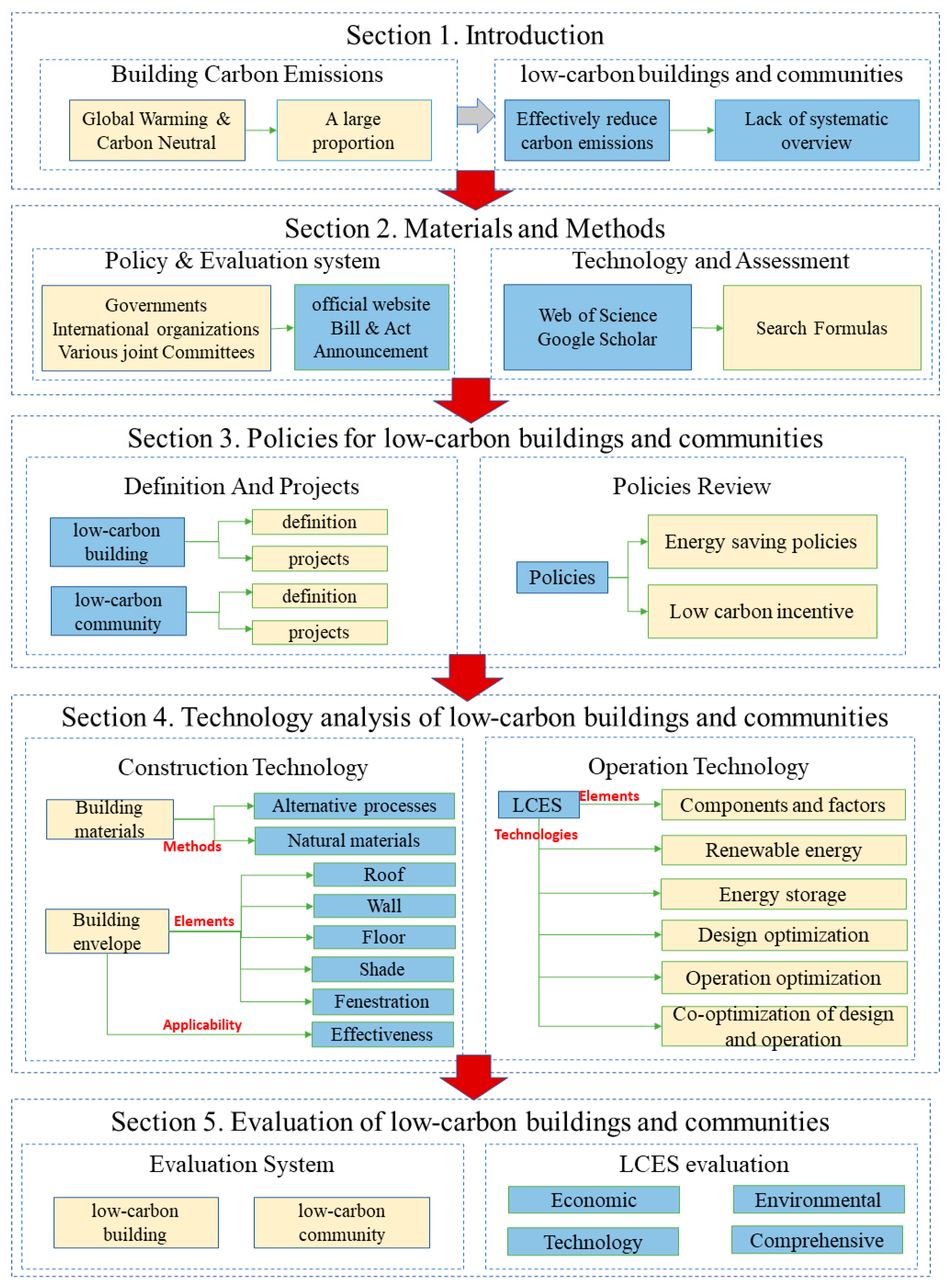
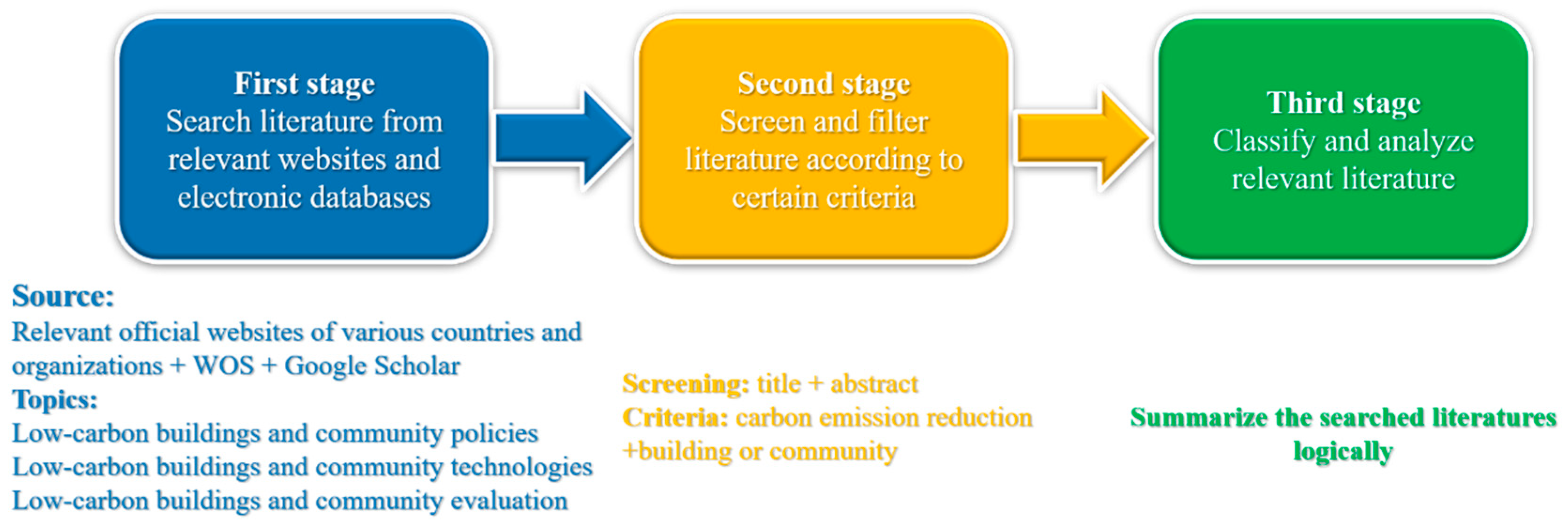
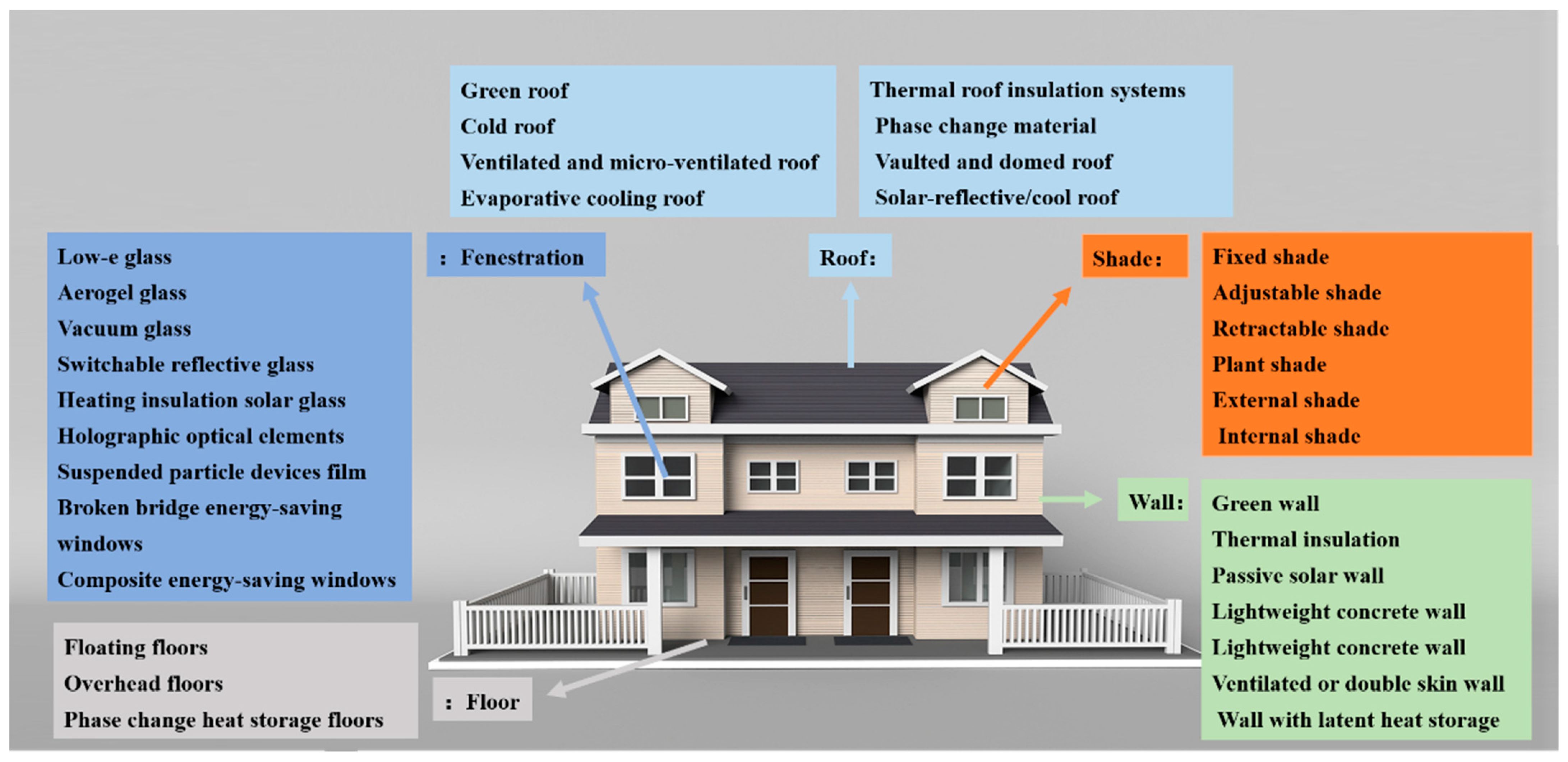
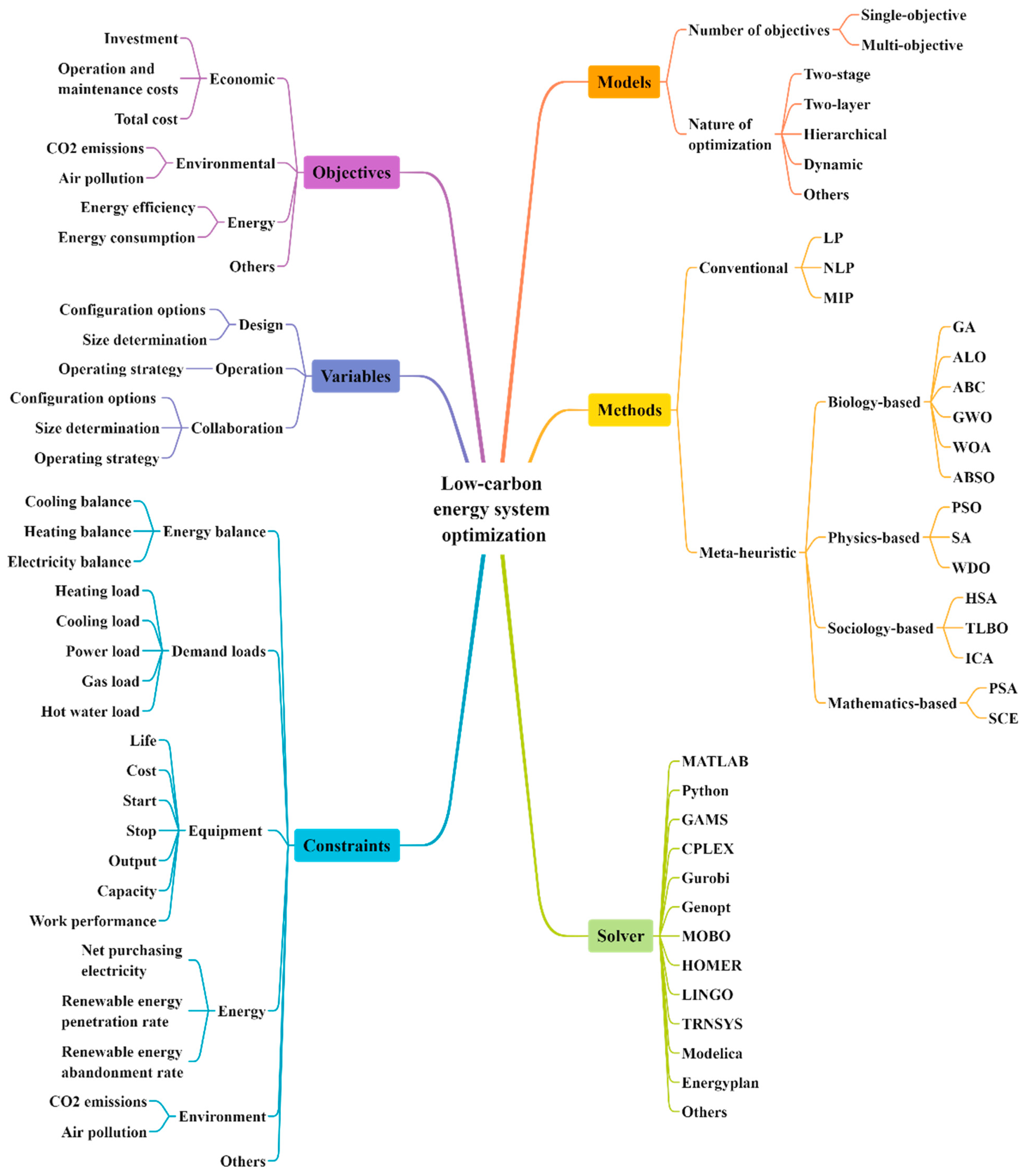
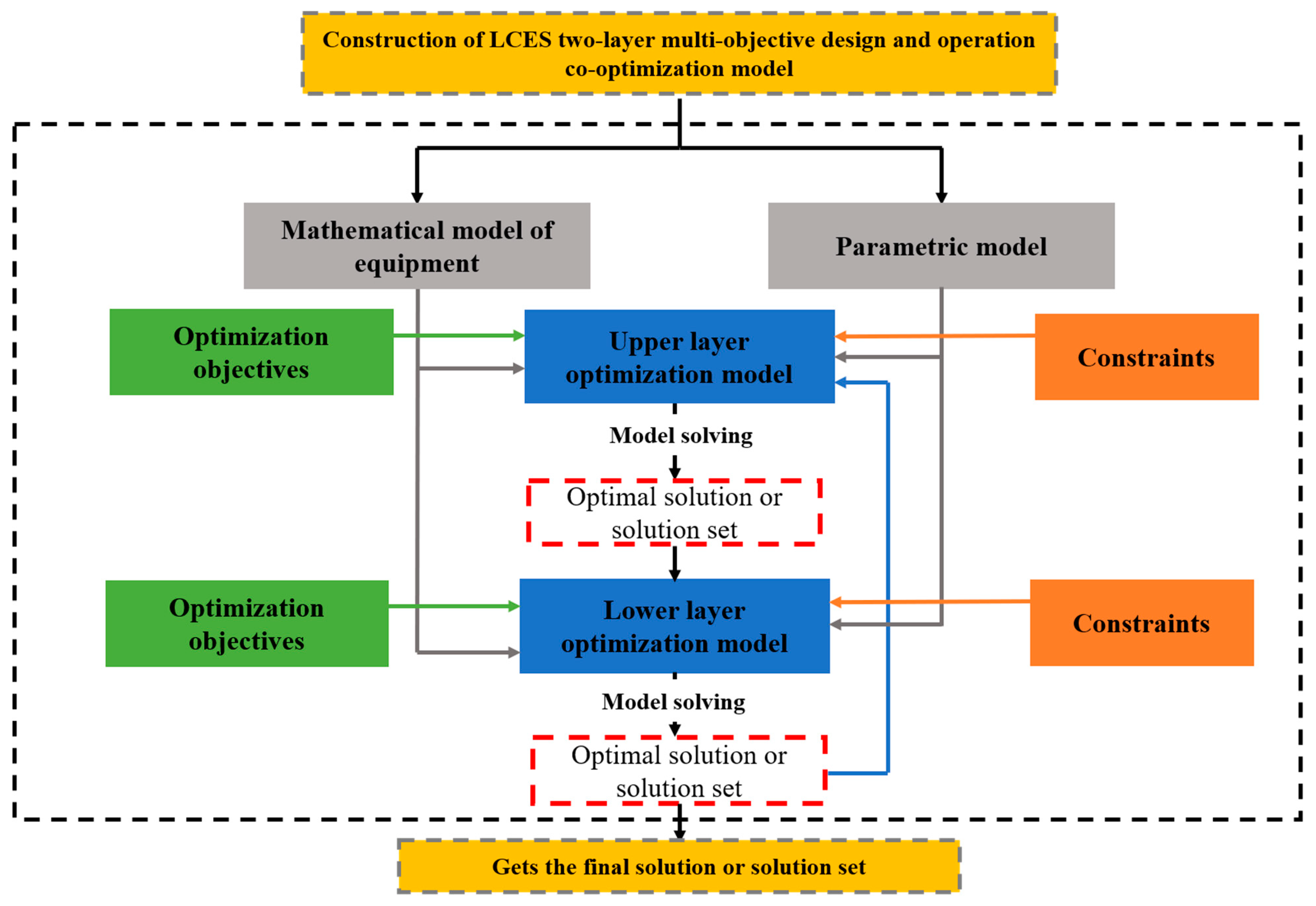
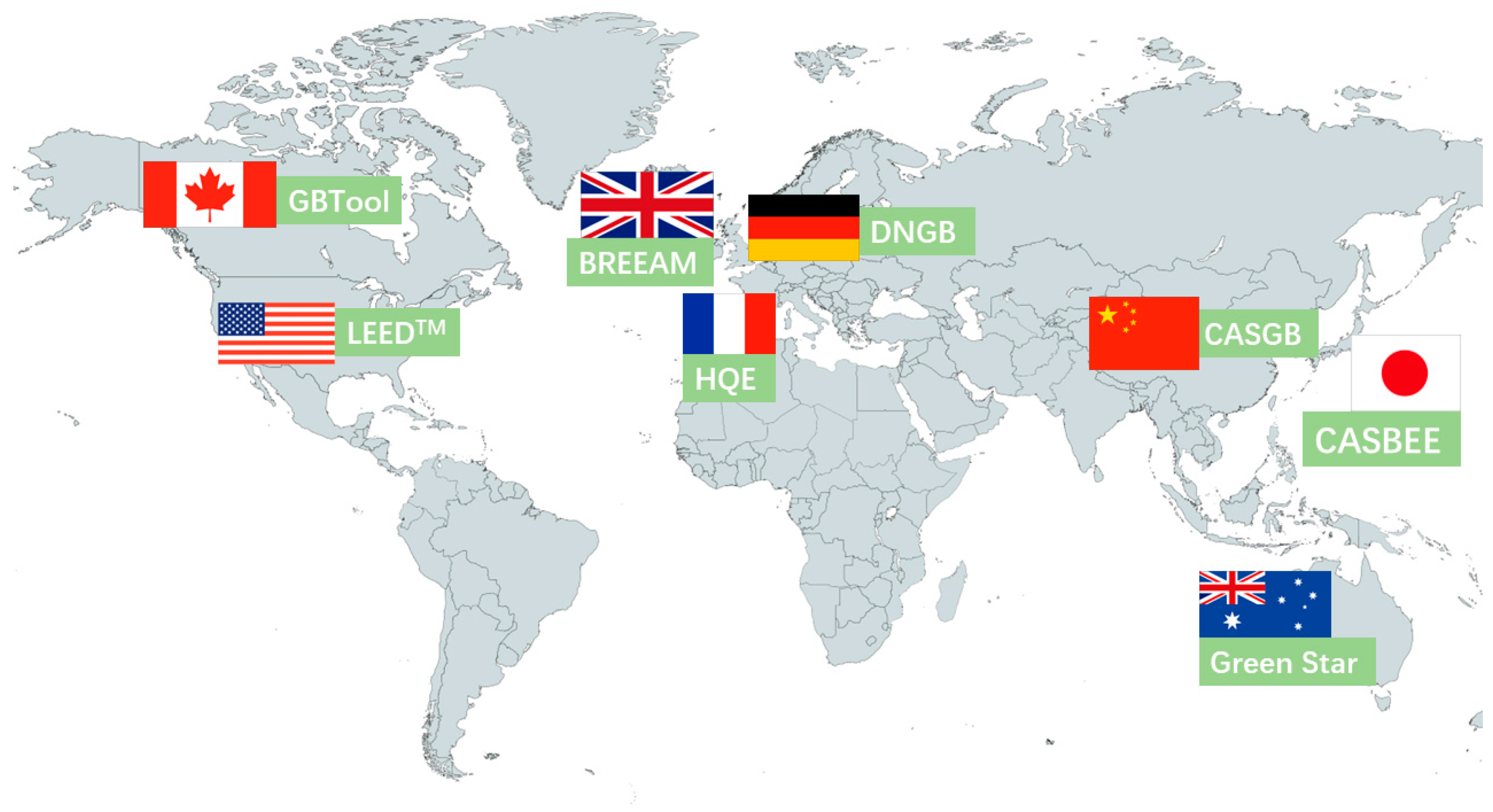
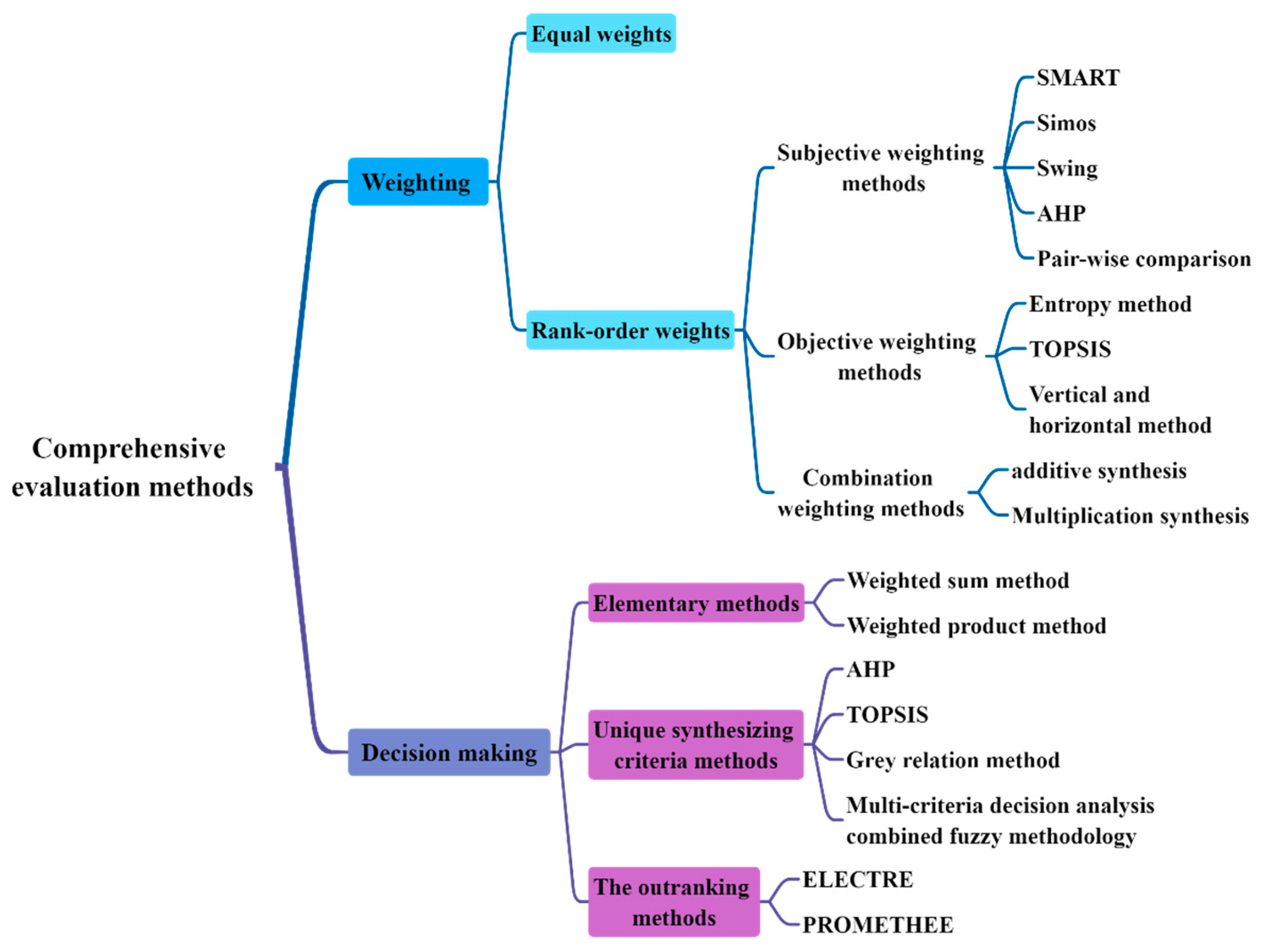
| Refs. | Country/Organization | Climate and Energy Act (Last Revision Year) | Content and Objectives |
|---|---|---|---|
| [4] | European Union | European Green Deal (2020) | Proposed a carbon reduction target for the EU to become carbon neutral by 2050. |
| [5] | European Climate Law (2020) | sets the target of the European Union becoming climate neutral by 2050. | |
| [6] | United Kingdom | Climate Change Act (2022) | The document formally commits the UK to becoming carbon neutral by 2050, creating a zero-carbon emitting society. |
| [7] | Germany | German Federal Climate Protection Law (2019) | Germany should reduce its total greenhouse gas emissions by 65 per cent from 1990 levels by 2030 and become carbon neutral by 2045. |
| [8] | Climate Action Plan 2030 (2021) | Specify specific action measures for each industry sector. | |
| [9] | France | National Low-carbon Strategy (2020) | France has established a carbon budget and set a target of achieving carbon neutrality by 2050. |
| [10] | Sweden | Climate Act (2017) | To achieve zero greenhouse gas emissions by 2045 and a 70% reduction in the transport sector by 2030. |
| [11] | New Zealand | Climate Change Response (Zero Carbon) Amendment Bill (2019) | By 2050, New Zealand will have zero greenhouse gas emissions, with the exception of biogenic methane from agriculture. |
| [12] | China | statements/commitments (2020) | strive to reach a peak before 2030 and strive to achieve carbon neutrality by 2060 |
| Refs. | Low-Carbon Building Materials | Introduction | Characteristics | Application |
|---|---|---|---|---|
| [51] | Precast Hollow Core Slabs | Commonly used in concrete flooring systems in innovative buildings. |
| Can be widely used in education and office buildings, warehouses and factories, apartments and shopping complexes, and also in wall panels. |
| [51] | Precast Half Slabs | A pre-stressed slab system applied with slab topping concrete. | Have high structural performance in terms of cracks and deflection control compared with standard concrete. | - |
| [51] | Steel Framework System | It consists of panels fabricated out of thin steel plates. |
| It is usually used in high-rise building construction and heavy concrete work. |
| [51] | Prefabricated Timber Frame System | - | The material can form a skeletal structure which can transfer the loads through large spans. | It can be used for building warehouses, bridges, and industrial buildings. |
| [51] | Glued Laminated Timber | It is a composite of individual solid laminated woods. |
| - |
| [53] | Ground Granulated Blastfurnace Slag | - |
| - |
| [51] | Pulverized Fuel Ash | It is a by-product of coal-powered power stations. |
| - |
| [54] | Unfired Brick | - |
| Can be used in the development of walls. |
| [55] | Ethylene Tetrafluoroethylene | It is a fluorine-based plastic and more robust than polytetrafluoroethylene. | Has 95% light transmission and flexibility. | Can be used as cladding for buildings. |
| [56] | Geopolymer Concrete | It is made from GGBS and fly ash. | Can reduce carbon emissions and stock wastage. | - |
| Refs. | Categories | Principle | Illustration | Advantage | Disadvantage |
|---|---|---|---|---|---|
| [74,75,76,77,78] | Electrochromic | It can reversibly modulate the optical properties upon application of potential. | 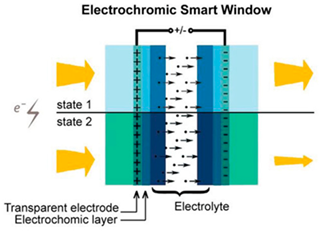 | It can reduce energy consumption, offer privacy and comfort for occupants | It requires the multilayered structure, electric control system and one-time low energy input. |
| [74,79,80,81,82] | Thermochromic | Its transparency can be changed according to the temperature, which allows it passively modulate the light adaptively in respond to the dynamic ambient temperature. | 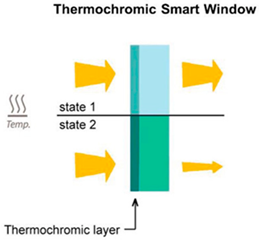 | (1) It can reduce energy consumption by automatically transmitting more indoor solar irradiation in cold days than in hot days without extra energy input. (2) it is purely driven by materials and does not require additional control systems. | Its properties depend on the climatic conditions. |
| [74] | Mechanochromic | Either the internal structures or surface morphologies of composed mechanoresponsive optical materials can be deformed and reconfigured by mechanical strain, which alters the optical transmittance through scattering or diffraction of visible light. | 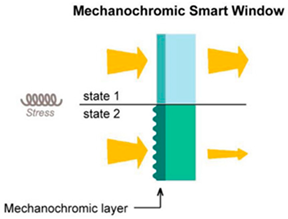 | It has simple construction, low cost and fast response time. | It requires mechanical control systems and additional control. |
| [74] | Photochromic | It can reversibly change its color when exposed to certain wavelengths of light. | 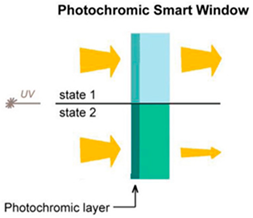 | It allows simple fabrication without extra energy input, similar to the thermochromic windows | It is only suitable for tropic countries |
| Refs. | System Type | Application | Heating Equipment | Cooling Equipment | Electricity Equipment | Energy Storage Equipment |
|---|---|---|---|---|---|---|
| [92] | DES + IES + MES | Comprehensive community | STC + GB + WHRU | ASHP + AC | PV + ICE + Grid | HWT + LB |
| [93] | IES | University | WHB + GB | AC + EC | PV + WT + GT + Grid | AA-CAES |
| [94] | Microgrid | Commercial buildings | - | - | PV + Grid | Micro PHS |
| [90] | Microgrid | - | - | - | PV | HDS + LB |
| [95] | DES + MES | Office building | FC-CHP + solar heating system | AC | PV + FC-CHP + Grid | HWT + CWT + HDS |
| [96] | IES | Commercial building | WHRU + GB + EB | AC + EC | GT + PV + WT + Grid | - |
| [86] | HES + RES | Residential buildings | - | - | PV + WT + DG | LB |
| [87] | RES | Residential building | STC + HP + GB | AC + EC | PV + WT+ Grid | HWT |
| [89] | HES | Mixed-type building | district heating + HP | district cooling + HP | PV + Grid | HS + CS + ES |
| [88] | HES | Hospital/hotel/office | STC + WHRU + GB + HE | AC + EC | PV + ICE + Grid | HWT |
| [97] | IES | Building | WHRU + EB +GSHP | AC + GSHP | PV + WT + GT + Grid | HWT + CWT + ES |
| [98] | MES | University | Hydrogen-fired boiler + ASHP + GSHP + biogas CHP | ASHP + GSHP | PV + WT + HDE + biogas CHP + Grid | HWT + CWT + HDS |
| [99] | IES | Residential communities | WHRU + EB + GB + HE | EC + AC | PV + WT + GT | ES |
| Refs. | Electricity Storage | Principle | Advantages | Disadvantages |
|---|---|---|---|---|
| [90] | LB | - | High energy density, high carrying capacity, high operating voltage, low self-discharge rate, no memory effect, high adaptability to high and low temperatures, environmental protection, long service life | Expensive for large scale applications |
| [93] | CAES | Use of electrical energy for compressed air storage during low load demand and release compressed air to drive the turbine for power generation during peak load demand | Can be applied in a large scale, and can be discharged for tens of hours and at a low cost | Technological barriers in safe and stable operation |
| [94] | PHS | When water is pumped from the lower pool to the upper pool, the electrical energy is converted into potential energy of the water and stored, and the potential energy is converted into electrical energy when the water flows from the upper pool to the lower pool through the turbine. | Can be applied in a large scale, with capacities up to 1 GW, and can be discharged for tens of hours and at a low cost | Limited by geographical location |
| [102] | GLIDES | By pumping liquid from the reservoir into the pressure vessel to compress condensable gases such as air and CO2 in the pressure vessel for energy storage, the high-pressure gas then pushes the water from the high-pressure head through the turbine to flow back into the reservoir for discharge | There are no restrictions on the installation location, a variety of low-grade heat sources can be integrated and waste heat can be used to improve discharge efficiency | - |
| [90] | HDS | Hydrogen production by electrolysis of water for FC power generation | High energy density per unit mass, clean and pollution-free, etc. | - |
| Refs. | Application | Single- Objective | Multi-Objective | Methods | Solvers | Considerations |
|---|---|---|---|---|---|---|
| [86] | Off-grid hybrid RESs | √ | PSO + ε-constraint | MATLAB | Effects of climate change and building energy performance | |
| [87] | A RES for nearly zero energy buildings | √ | GA | MATLAB | climate change and energy price variations in the future | |
| [88] | A solar hybrid CCHP system | √ | PSO | MATLAB | Influence of building type and climate condition | |
| [98] | Carbon-neutral energy systems of Cornell University campus | √ | Global optimization algorithm | GAMS | Climate neutrality and 100% renewables | |
| [103] | A hybrid microgrid-hydrogen storage facility in Saudi Arabia | √ | Repeated algorithm | HOMER | Five configurations and hydrogen production | |
| [105] | A solar heating system | √ | Hooke-Jeeves | TRNSYS + GenOpt | Combination of phase change energy storage tank and electromagnetic heating unit | |
| [106] | Stand-alone photovoltaic/wind-generator systems | √ | GA | - | System design characteristics such as the PV modules tilt angle, the WT installation height and the number of battery chargers | |
| [107] | A low temperature local hybrid energy system | √ | GA | TRNSYS + MATLAB + MOBO | Cross-seasonal storage of solar energy by a bore thermal energy storage |
| Refs. | Application | Single- Objective | Multi-Objective | Methods | Solvers | Considerations |
|---|---|---|---|---|---|---|
| [93] | IES | √ | - | - | The AA-CAES storage model, a stair-step carbon trading mechanism and several scenarios | |
| [94] | The building-integrated microgrid | √ | - | - | Photovoltaic and pumped storage | |
| [96] | Low-carbon oriented IES in commercial building | √ | MIP | CPLEX | Electric vehicle and DR | |
| [97] | IESs a building in Northeast China | √ | Improved ALO | - | Comparison with standard PSO algorithm and standard ALO algorithm | |
| [95] | Distributed Hydrogen-based MES | √ | MIP | Gurobi | Emissions trading schemes, carbon emissions reductions formulated by economic benefit | |
| [109] | Zero-carbon multi-energy system | √ | ROSO + MILP | Gurobi | Incorporating Electric Vehicle (EV) multi-flexible approach, virtual powerplant | |
| [110] | Multi carrier energy systems | √ | MILP | CPLEX | The thermal energy market and DR | |
| [112] | Solar hybrid CCHP systems of an office building in Beijing | √ | PSO | - | Redundant design | |
| [113] | IESs of a hotel in northern China | √ | GA + SDP | MTALAB | Energy storage and DR |
| Refs. | Application | Single-Objective | Multi-Objective | Methods | Solvers | Considerations |
|---|---|---|---|---|---|---|
| [90] | PV-Hydrogen Zero Carbon Emissions Microgrid | √ | PSO | - | A scheduling strategy considering the minimum operational cost of energy storage equipment | |
| [89] | HES for a mixed-type building in Finland | √ | Dynamic LP/MILP | - | A mixed-type building with commercial, office, and residential parts | |
| [92] | A novel distributed energy system integrated with hybrid energy storage in different nearly zero energy community scenarios | √ | NSGA-II + TOPSIS | - | 12 nearly zero energy community scenarios considering different community types and scales with electric vehicles as a new-type load | |
| [117] | DES | √ | Fmincon functions and SQP algorithm | MATLAB | The time-varying operation of the energy conversion units in response to electricity and hydrogen demands as well as the seasonal behavior of the storage system | |
| [118] | IES | √ | MILP + the ε-constraint + LINMAP | Python | Precision and scale difference | |
| [116] | A new DES that combines multi-energy storage for a nearly zero energy community | √ | NSGA-II + TOPSIS | - | Three modes of EV charging | |
| [115] | A DES combining multiple energy storages | √ | NSGA-II + TOPSIS | - | Comparation of the two-layer co-optimization method proposed, multi-parameter co-optimization method, two-stage co-optimization method and two- layer nested co-optimization method | |
| [114] | CCHP microgrid system for a hospital in the southern China | √ | NSGA-II + MILP | - | The total net present cost and CO2 emission |
| Refs. | Countries | Evaluation Standard | Evaluation Content |
|---|---|---|---|
| [127] | The United States | LEEDTM | Sustainable Sites, Water Efficiency, Energy & Atmosphere, Materials & Resources, Indoor Environmental Quality, Innovation & Design Process. |
| [123] | Germany | DNGB | Environmental Quality, Economic Quality, Sociocultural and Functional Quality, Technical Quality, Process Quality, Site Quality. |
| [128] | Britain | BREEAM | Management, Health & Wellbeing, Energy, Transport, Water, Material, Waste, Land Use & Ecology. |
| [129] | Canada | GBTool | Environmental Sustainability Indicators, Resource Consumption, Environmental Load, Indoor Air Quality, Maintainability, Economy, Operation Management. |
| [130] | Australia | Green Star | Management, Indoor Environment, Energy, Transportation, Water, Material Saving, Land Use and Ecology, Emissions, Innovation. |
| [126] | China | CASGB | Safety and Durability, Health and Comfort, Convenience of Life, Resource Saving and Livable Environment. |
| [131] | France | HQE | Eco-construction target, Eco-management target, Comfort target, Health target. |
| Refs. | Economy | Environment | Technology | Comprehension |
|---|---|---|---|---|
| [117] | √ | √ | √ | |
| [141] | √ | |||
| [109] | √ | |||
| [142] | √ | √ | √ | √ |
| [92] | √ | √ | √ | √ |
| [143] | √ | √ | √ | |
| [93] | √ | √ | √ | |
| [90] | √ | √ | √ | √ |
| [95] | √ | √ | √ | |
| [144] | √ | √ | √ | √ |
| [145] | √ | √ | √ | √ |
| [146] | √ | √ | ||
| [147] | √ | √ | √ | √ |
| [148] | √ | √ | ||
| [149] | √ | √ | √ | √ |
| [150] | √ | √ | √ | √ |
| Refs. | Criteria | Formula | Parameters Description |
|---|---|---|---|
| [141] | Investment cost | Where are the vector of equipment capacities, IC is the vector of unit investment cost for each. | |
| [151] | Operation and maintenance cost | Where is considered as a percentage of the annual investment cost of the equipment; is the capital cost. | |
| [103] | Net present value | Where is the system lifetime in years; is the discount rate; is the capital cost of a system component; is the operation and maintenance cost; represents the fuel cost; is the replacement cost and is the salvage value. | |
| [103] | Annual total cost | Where is the capital recovery factor. | |
| [103] | Levelized cost of energy | Where is the marginal cost of boilers; is the total thermal load served and is the total electrical load served. | |
| [92] | Annual cost per unit supply area | ; | Where is gross floor area, AC is the annual cost (AC) including initial investment cost (), annual operation cost (), natural gas consumption cost (), power punishment cost (), and power purchase cost from the state grid (). |
| [144] | Simple payback period | Where are the capital cost of conventional energy system and LCESs respectively. The OPEX is the total operation cost of g years. |
| Refs. | Criteria | Formula | Parameters Description |
|---|---|---|---|
| [148] | Energy efficiency | is the solar energy input. | |
| [148] | Exergy efficiency/Second-law efficiency/rational efficiency | are the mean temperatures of the refrigerated water, domestic hot water and solar collector, respectively. | |
| [148] | Primary energy ratio | The solar subsystems: The biomass subsystems: | is the solar energy input. |
| [145] | Primary energy saving ratio | represents all primary energy consumption of SP system. | |
| [151] | Net interaction level | is the electricity sold to the grid at time t. | |
| [90] | Load loss probability | is the equivalent load of the whole LCES. |
Disclaimer/Publisher’s Note: The statements, opinions and data contained in all publications are solely those of the individual author(s) and contributor(s) and not of MDPI and/or the editor(s). MDPI and/or the editor(s) disclaim responsibility for any injury to people or property resulting from any ideas, methods, instructions or products referred to in the content. |
© 2023 by the authors. Licensee MDPI, Basel, Switzerland. This article is an open access article distributed under the terms and conditions of the Creative Commons Attribution (CC BY) license (https://creativecommons.org/licenses/by/4.0/).
Share and Cite
Li, Y.; Li, S.; Xia, S.; Li, B.; Zhang, X.; Wang, B.; Ye, T.; Zheng, W. A Review on the Policy, Technology and Evaluation Method of Low-Carbon Buildings and Communities. Energies 2023, 16, 1773. https://doi.org/10.3390/en16041773
Li Y, Li S, Xia S, Li B, Zhang X, Wang B, Ye T, Zheng W. A Review on the Policy, Technology and Evaluation Method of Low-Carbon Buildings and Communities. Energies. 2023; 16(4):1773. https://doi.org/10.3390/en16041773
Chicago/Turabian StyleLi, Ye, Shixuan Li, Shiyao Xia, Bojia Li, Xinyu Zhang, Boyuan Wang, Tianzhen Ye, and Wandong Zheng. 2023. "A Review on the Policy, Technology and Evaluation Method of Low-Carbon Buildings and Communities" Energies 16, no. 4: 1773. https://doi.org/10.3390/en16041773
APA StyleLi, Y., Li, S., Xia, S., Li, B., Zhang, X., Wang, B., Ye, T., & Zheng, W. (2023). A Review on the Policy, Technology and Evaluation Method of Low-Carbon Buildings and Communities. Energies, 16(4), 1773. https://doi.org/10.3390/en16041773







